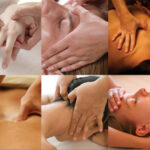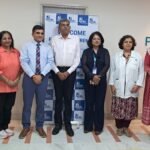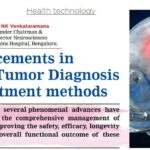Photo Biomodulation Therapy is now a new frontier of Brain And Body Science. It is the ability to influence cellular, body, and Brain health using Concentrated source of light. More Specifically, Low Level Laser Therapy(LLLT) or cold Lasers. Multiple studies show that LLLT can significantly reduce brain damage and improve recovery outcomes after a stroke.
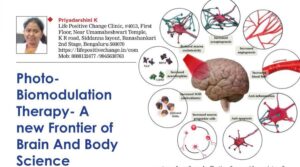

What is Photo-Bio-Modulation?
The Ability to influence cellular, body, and Brain health using Concentrated source of light. More Specifically, Low Level Laser Therapy (LLLT) or Cold Lasers.
How LLLT works?
In a Nutshell, Photons(particles of light Energy) are absorbed by specific light receptors in our cells ( photo-receptors), triggering chemical alterations and bio-chemical, physical and neurological benefits to the human brain and body. This is done by safely passing concentrated, high energy beam of light through the skin by sophisticated diodes; or the laser light generators.
Think of all the benefits of being out in the sun; although concentrated and without the danger of over-exposure. Low level lasers are ‘Cold’, meaning they are at a highly specific light frequency and the power that does not produce heat and cause potential harm to body tissue. This, while providing the ‘gift of life’ that light possesses for all living things on our planet.
What Does LLLT Do?
For decades, low-level lasers have been shown to have a positive impact on the following:
1. Recovery from brain injury and concussion
2. Metabolic activity and energy production within brain and body cells
3. Neuroplasticity and neurogenesis (production of new brain cells)
4. Memory, learning and mood
5. Inflammation reduction
6. Blood flow and oxygenation with tissue repair and regeneration
7. Cell signaling and communication
8. Antioxidant production and removal of waste products from cells
9. Chronic pain and lowered dependence on prescription drugs
10. Immune function
While the list of benefits continues to grow, it is important to understand that low-level lasers are extremely safe and effective for a wide variety of health conditions. *(a sampling of relevant papers and articles follows below).


Who Benefits from LLLT?
Just as the list of positive impacts with LLLT grows through mounting scientific evidence; so does the list of conditions that can benefit from LLLT. Conditions including, but not limited to:
1. Traumatic brain injury, concussion and stroke
2. Cognitive impairment, dementia and Alzheimer’s
3. Mood disorders and addiction
4. Disorders of development, learning and behavior (including ADHD and autism)
5. PTSD and SAD
6. Neurodegenerative diseases (i.e. Parkinson’s, multiple sclerosis, etc.)
7. Insomnia
8. Tinnitus
9. Head and face pain
10. Pain syndromes requiring opiate or other pain medication interventions
Of extremely important note is the increasing number of athletes, scholars, and other individuals utilizing LLLT for optimal (peak) performance, injury prevention, cognitive enhancement, and other pro-active brain and body health strategies.
Use of LLLT in treating Depression and Anxiety
Studies in rats and humans provide evidence that LLLT improves mood and decreases depressive symptoms. In 2009, researchers took 10 patients with a history of major depression and anxiety (including post-traumatic stress disorder and substance abuse) and applied LLLT to their foreheads for four weeks. At the end of the study, six of the 10 patients experienced a remission of their depression, and seven of the 10 patients experienced a remission of their anxiety. There were no observable side effects.
“The data supports that LLLT to the head constitutes a promising neurotherapeutic tool to modulate behaviour in a non-invasive manner.” — Dr. Julio C. Rojas, MD, PhD, University of California.
This makes sense considering that several studies show that depression is linked to abnormal blood flow in the frontal cortex of the brain, and LLLT increases blood flow and circulation. Other studies have shown that participants report a significant increase in positive emotions and a reduction in depressive symptoms for two weeks after LLLT treatment.
Sufferers of traumatic brain injury (TBI) also experience a decrease in depression, anxiety, irritability and insomnia, and an overall improvement in quality of life, because of LLLT.
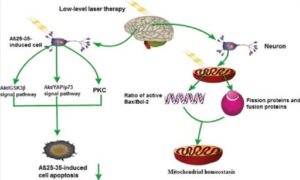

LLLT in treating Alzheimer’s Disease, Parkinson’s disease, and Cognitive Impairment:
Research shows that LLLT can boost performance and improve cognitive function, including attention and memory, in elderly people, young healthy people and animals. Preliminary studies demonstrate that LLLT could slow down the progression of Alzheimer’s disease by decreasing a protein in the brain that is linked to dementia.
Downregulation of brain-derived neurotrophic factor (BDNF) occurs early in the progression of Alzheimer’s disease, and LLLT has been shown to prevent brain cell loss by upregulating BDNF.
“LLLT could be used as a preventive intervention in people who present risk factors for Alzheimer’s disease, mild cognitive impairment, or a history of head trauma. In such patients, LLLT could be combined with cognitive intervention approaches.” – Dr. Francisco Gonzalez-Lima, PhD, University of Austin, Texas
Researchers have also applied LLLT to middle-aged mice, and discovered that the memory and cognitive performance of the middle-aged mice improved so much that it was comparable with that of young mice. The researchers concluded that LLLT should be “applied in cases of general cognitive impairment in elderly persons”.
Several others studies have shown that LLLT significantly increases alertness, awareness and sustained attention, and improves short-term memory and reaction time. Study participants also made fewer errors during tasks and tests. Another study found that LLLT was just as effective as exercise at enhancing cognition, likely by providing neuroprotection and supporting the mitochondria.
LLLT in treating Stroke
Multiple studies show that LLLT can significantly reduce brain damage and improve recovery outcomes after a stroke. In one study, researchers applied LLLT over the entire surface of the head of stroke patients approximately 18 hours after a stroke. Five days after the stroke, they found significantly greater improvements in the LLLT-treated group. The improvements continued 90 days after the stroke. At the end of the study, 70% of the patients treated with real LLLT had a successful outcome compared with only 51% of the control subjects.
Follow up studies with over 600 stroke patients found similar beneficial results. Researchers believe an increase in the production of ATP is responsible for the improvements. Numerous studies also show that LLLT significantly reduces neurological problems and improves behaviour in rats and rabbits after stroke. It also increases the growth of new brain cells in these animals, improving their overall recovery.


Priyadarshini K
Life Positive Change Clinic, #4013, First Floor, Near Umamaheshwari Temple,
K R road, Siddanna layout, Banashankari 2nd Stage, Bengaluru 560070
https://lifepositivechange.in/com
Mob: 8088132477 /9945638763
(Author is Registered Clinical Psychologist at BICA & IPOS.
Reproductive health counselor and Clinical Psycho-oncologist).
Trained photo-biomodulation therapist.)
For Evidence Based Support:
1. TBI – https://www.ncbi.nlm.nih.gov/pubmed/17439348
2. Depression and Alzheimer’s –
http://www.jneuropsychiatry.org/peer-review/transcranial-lowlevel-laser-therap y-for-depression-and-alzheimers-disease.pdf
3. Neurological rehabilitation – https://www.ncbi.nlm.nih.gov/pmc/articles/PMC3065857/
4. Parkinson’s and Alzheimer’s – https://www.ncbi.nlm.nih.gov/pmc/articles/PMC4707222/
5. Autism – https://www.ncbi.nlm.nih.gov/pubmed/29956199
6. Addiction – https://www.medicalnewstoday.com/articles/258703.php
7. Immune function – https://www.ncbi.nlm.nih.gov/pubmed/8126975
8. TBI – https://www.ncbi.nlm.nih.gov/pmc/articles/PMC3104287/
9. Sleep – https://www.ncbi.nlm.nih.gov/pubmed/23171567
10. Pain–https://aim.bmj.com/content/34/5/328



